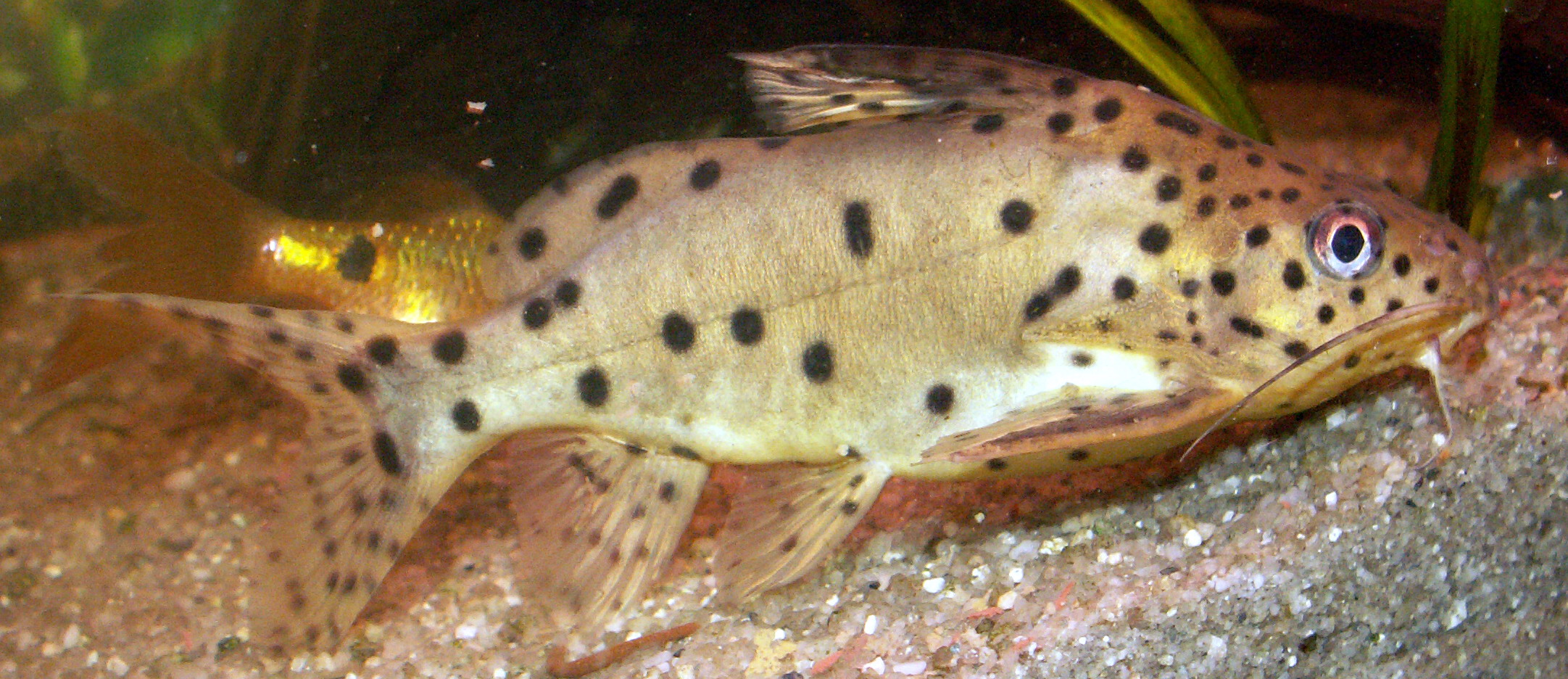- Synodontis
Taxobox
fossil_range = EarlyMiocene - Recent
name = "Synodontis"

image_width = 250px
image_caption = "Synodontis njassae "
regnum =Animal ia
phylum = Chordata
classis =Actinopterygii
ordo = Siluriformes
familia =Mochokidae
genus = "Synodontis"
genus_authority = Cuvier, 1816
type_species = "Silurus clarias"
type_species_authority = Linnaeus, 1758
subdivision_ranks = Species
subdivision = See text.
synonyms =
*"Leiosynodontis" Bleeker, 1862
*"Pseudosynodontis" Bleeker, 1862"Synodontis" is the largest
genus ofcatfish es (order Siluriformes) of the familyMochokidae . "Synodontis" may be known as "squeakers" due to their ability to make stridulatory sounds through theirpectoral fin spines when handled or disturbed. Some species are also known for naturally swimming belly-up, earning the nameupside-down catfish .Distribution
"Synodontis" is the most widely-distributed mochokid genus. "Synodontis" species occur throughout most of the freshwaters of sub-
Sahara n Africa and theNile River system. "Synodontis" species are found throughout Africa, except in the southernmost parts and theMaghreb , although most species occur in Central andWest Africa . Their distribution is similar to that ofcichlid s, including theAfrican Great Lakes and surrounding rivers.cite journal|first=Stephan|last=Koblmüller|coauthors=Sturmbauer, Christian; Verheyen, Erik; Meyer, Axel; Salzburger, Walter|journal=BMC Evolutionary Biology|year=2006|volume=6|issue=49|pages=1–16
doi = 10.1186/1471-2148-6-49
unused_data = Mitochondrial phylogeny and phylogeography of East African squeaker catfishes (Siluriformes: "Synodontis")]It has been found that
East Africa n "Synodontis" species form amonophyletic groupderived than the Central and West African species. The East Africanclade includes six lineages: "S. zambensis"; "S. nigromaculata"; "S. victoriae" inLake Victoria ; "S. njassae" inLake Malawi ; "S. granulosa" and "S. multipunctata" inLake Tanganyika ; and "S. dhonti", "S. polli", and an undescribed species, also in Lake Tanganyika. "Synodontis" spread into East Africa prior to the formation of the African Great Lakes. The ancestral, colonizing species would have split into these six separate lineages within a relatively short period of time; later, these lineages may have diversified further.Fossil record
The earliest fossils of "Synodontis" in East African are from the Early
Miocene .Description
These fish are small- to medium-sized fish.
Ecology
"Synodontis" species are omnivorous generalists, feeding on a wide spectrum of different foods and are largely unspecialized. They are bottom-feeders and may be
detrivore s, some species may also be able to adapt to filter feeding. This allows them to cope with seasonal and habitat changes and gives them a better ability to colonize different habitats. Species of "Synodontis" have been noted to reproduce with the flooding period of therainy season .Relationship to humans
Larger "Synodontis" species are important as
seafood . Many "Synodontis" species are also prized ornamental fish in thefishkeeping hobby .pecies
"Synodontis" includes about 120
species . "Synodontis" accounts for about one-quarter of African catfish species. This genus has more members than any otherAfrica nteleost genus other than "Barbus " and "Haplochromis ".cite journal|url=http://www.naturalsciences.be/institute/associations/rbzs_website/bjz/back/pdf/BJZ%20136(2)/Volume%20136(2),%20pp.%20193-201.pdf|title=Studies on the biology of two species of catfish "Synodontis schall" and "Synodontis nigrita" (Ostariophysi : Mochokidae) from the Ouémé River, Bénin|first=Philippe|last=Lalèyè|coauthors=Chikou, Antoine; Gnohossou, Pierre; Vandewalle, Pierre, Philippart, Jean Claude; Teugels, Guy|journal=Belg. J. Zool.|volume=136|issue=2|pages=193–201|date=July 2006|format=PDF ]The species list below is according to Ferraris, 2007; a number of species have been changed to fit the feminine gender of the genus.cite journal|url=http://silurus.acnatsci.org/ACSI/library/biblios/2007_Ferraris_Catfish_Checklist.pdf|title=Checklist of catfishes, recent and fossil (Osteichthyes: Siluriformes), and catalogue of siluriform primary types|first=Carl J., Jr.|last=Ferraris|journal=
Zootaxa |volume=1418|pages=1–628|year=2007|format=PDF ] Newer species are listed with references.References
Wikimedia Foundation. 2010.
